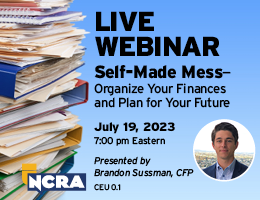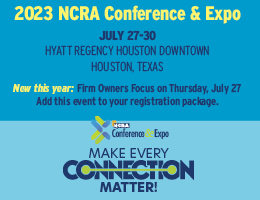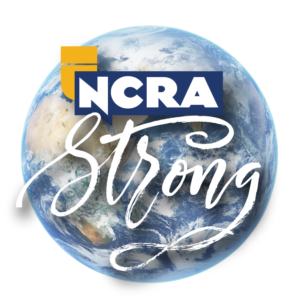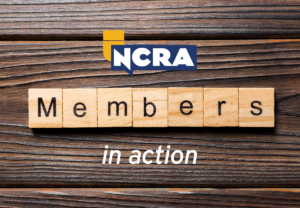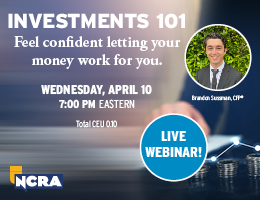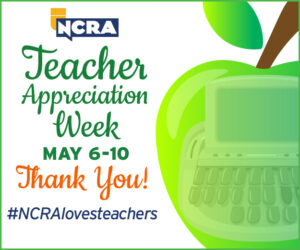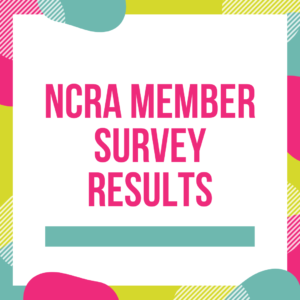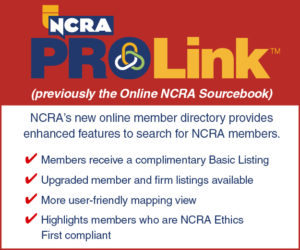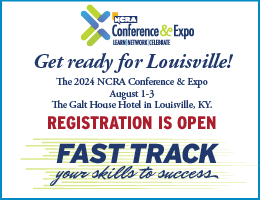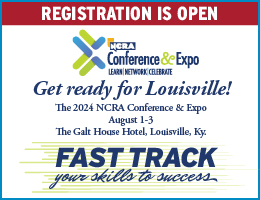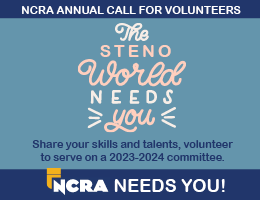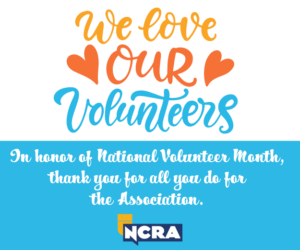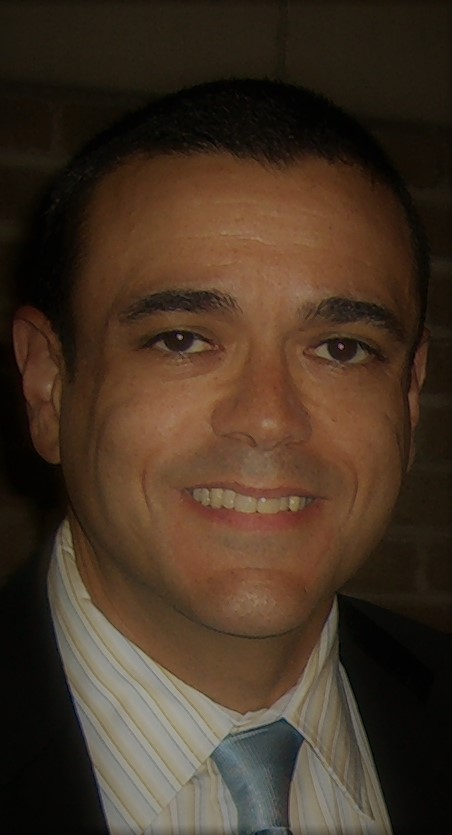
Captioner Steve Clark, CRC, based in Washington, D.C., recently visited NCRA headquarters to demonstrate realtime and captioning skills to staff. Steve has an engaging presentation style and lots of experience sharing his story with various audiences, so the JCR Weekly asked him to provide some insight and advice for other captioners, court reporters, and legal videographers on the keys to successful group presentations.
JCR | Can you tell us a little bit about your presentations and what they are used for?
SC | I have about six slide shows that I can choose from, depending on the group I am presenting to and the length of time for which I am asked to present.
One slide show, for example, is a basic “What is CART Captioning?” presentation. This presentation has about 15 slides and introduces potential clients to the basics of onsite and remote CART captioning – how it works, who it benefits, and steps to take to request and set up CART captioning services.
Another slide show is geared toward students and explains how the steno machine works, what CART captioning is, who is a good candidate for this career, and the necessary steps to get started as a student. This slide show can also be used when speaking to civic groups or deaf and hard-of-hearing groups about what we do and how we do it – in other words, answering the common question of “How does that little machine work?”
I have a slide show that I use when speaking to professional court reporting and captioning associations, particularly focused on writing theories and shortcuts for briefing. This slide show can be used for a shorter presentation of 60-90 minutes. I also have created an expanded version of this last slide show. This expanded version is for an all-day presentation to fellow professionals. And I have specialized presentations when speaking to a group about, for example, sports captioning or stadium captioning.
JCR | What are the most important points that you feel you need to cover in your presentation?
SC | It really depends on the audience. If my goal is to help a general audience to understand what we do and how we do it, it is important to explain the basics of the steno machine and why we still use it, particularly why I feel it is the best and most accurate way to produce realtime captions. If I am presenting to a group of fellow captioners or court reporters, I can move more quickly, but I feel it is always important to leave plenty of time for Q&A, which the group of fellow professionals will surely have.
JCR | Do you get nervous about presenting to people? Do you have any suggestions for getting over being nervous?
SC | Now when I present, I don’t get nervous. When I first started presenting, I certainly did get nervous. My three suggestions for not getting nervous are:
- Be yourself, but be professional, courteous, and make everyone feel welcome. Speak naturally, but slowly enough that your audience can really absorb what you are saying. And try to speak properly – no “like” and “you know” or other filler words. Having been an audience member, I find that concise speakers are the most attractive speakers.
- Know your material. Practice, practice, practice. This means practicing your presentation out loud at least five times. Practice makes perfect.
- When I first started presenting and felt the nerves coming on, I would remind myself: “I am the most qualified person in the room to be doing this presentation.” That isn’t meant to sound arrogant or cocky, but rather to remind me that I have worked hard to get to this point; I have worked hard on this presentation and these slides; and I have the ability to present and to present well.
JCR | How does giving presentations help you or your business?
SC | Giving presentations has been a tremendous help to me personally as well as to my business. Whether I am giving a two-minute explanation to a client or audience member during a break at an onsite job or I am presenting to a room of perhaps 100 people, I am representing me, my business, this career, and anyone who counts on the service I am providing. Therefore, it is really important to develop good communication skills, but likewise good listening skills.
JCR | As a captioner, you probably see a fair amount of presentations yourself. Have you seen anything – other than captioning – that sets off a really great presentation from a mediocre one? Have you learned anything from them that you’ve been able to incorporate into your own presentations?
SC | As stated above, the best speakers, in my opinion, are concise, well-spoken, and well-prepared. A good speaker is also a good listener. When I am presenting, if there is a question or comment, I always try to do what I have seen many outstanding speakers do over the years – allow the question or comment to be stated, wait patiently and respectfully, thank the person, and then answer the question as asked. You always want your audience members to know that you value them and that you want them to be a part of this presentation, too.
I also learned from a seasoned member of the court reporting association I belonged to early on in my career that it is important to be deferential. Don’t be afraid to recognize the expertise of others and the tremendous things that the younger, up-and-coming professionals are doing in this field. Give credit where credit is due.
JCR | Do you have any advice for other court reporters or captioners on how to give presentations? Is there a good place to start?
SC | The first few times I presented, I was part of a panel. I was the junior member of the panel, meaning that all of the other panelists had 10 years or more of experience. I had only a year or two. Working on a panel allowed me to hone my skills as a presenter and to improve my slide-creation skills. Listen to how others speak, copy the formatting of others’ slides, and emulate the speakers you like. It is true that imitation is the sincerest form of flattery.
HLAA or similar groups are really receptive and are good places to begin. State or local court reporting associations are also great audiences for someone just starting out as a speaker or presenter.
JCR | A few days ago, someone sent an email about how being a speaker at an event is good for introverts because it gives them something that other people can approach them about and gives them something to talk about that isn’t small talk. Do you find this true?
SC | I definitely agree. And for introverts, it focuses the conversation on a topic that they can have some control over and that they are prepared to speak about. Once you get the speaking bug, though, you stop being an introvert.
JCR | Is there anything else you’d like to add?
SC | Two years ago at NCRA’s convention in Chicago, I was walking through the vendor area, just looking at different products and services being offered. A gentleman approached me and said, “Excuse me, are you Steve Clark?” I said, “Yes.” He said, “You probably don’t remember me, but I remember you. I’ve been hoping for some time that I would run into you again. I saw you speak to our state association in Massachusetts in 1999, and I want you to know what an impact you had on me.”
He went on to tell me how I inspired him to change his writing, to improve his realtime skills, and he wanted me to know that he even went on to present a few times to state associations and other groups.
That is why I love presenting and speaking. You don’t always know it, and sometimes you don’t find out until almost 20 years later, but you can make a difference, and you can influence someone, both professionally and personally. Anyone who is considering speaking or presenting – stop considering it. Do it! You’ll be glad you did.
